Geert Deconinck
Privacy-Preserving Distributed Learning for Residential Short-Term Load Forecasting
Feb 02, 2024Abstract:In the realm of power systems, the increasing involvement of residential users in load forecasting applications has heightened concerns about data privacy. Specifically, the load data can inadvertently reveal the daily routines of residential users, thereby posing a risk to their property security. While federated learning (FL) has been employed to safeguard user privacy by enabling model training without the exchange of raw data, these FL models have shown vulnerabilities to emerging attack techniques, such as Deep Leakage from Gradients and poisoning attacks. To counteract these, we initially employ a Secure-Aggregation (SecAgg) algorithm that leverages multiparty computation cryptographic techniques to mitigate the risk of gradient leakage. However, the introduction of SecAgg necessitates the deployment of additional sub-center servers for executing the multiparty computation protocol, thereby escalating computational complexity and reducing system robustness, especially in scenarios where one or more sub-centers are unavailable. To address these challenges, we introduce a Markovian Switching-based distributed training framework, the convergence of which is substantiated through rigorous theoretical analysis. The Distributed Markovian Switching (DMS) topology shows strong robustness towards the poisoning attacks as well. Case studies employing real-world power system load data validate the efficacy of our proposed algorithm. It not only significantly minimizes communication complexity but also maintains accuracy levels comparable to traditional FL methods, thereby enhancing the scalability of our load forecasting algorithm.
Combined Peak Reduction and Self-Consumption Using Proximal Policy Optimization
Nov 27, 2022Abstract:Residential demand response programs aim to activate demand flexibility at the household level. In recent years, reinforcement learning (RL) has gained significant attention for these type of applications. A major challenge of RL algorithms is data efficiency. New RL algorithms, such as proximal policy optimisation (PPO), have tried to increase data efficiency. Additionally, combining RL with transfer learning has been proposed in an effort to mitigate this challenge. In this work, we further improve upon state-of-the-art transfer learning performance by incorporating demand response domain knowledge into the learning pipeline. We evaluate our approach on a demand response use case where peak shaving and self-consumption is incentivised by means of a capacity tariff. We show our adapted version of PPO, combined with transfer learning, reduces cost by 14.51% compared to a regular hysteresis controller and by 6.68% compared to traditional PPO.
Anomaly Detection in Automatic Generation Control Systems Based on Traffic Pattern Analysis and Deep Transfer Learning
Sep 16, 2022
Abstract:In modern highly interconnected power grids, automatic generation control (AGC) is crucial in maintaining the stability of the power grid. The dependence of the AGC system on the information and communications technology (ICT) system makes it vulnerable to various types of cyber-attacks. Thus, information flow (IF) analysis and anomaly detection became paramount for preventing cyber attackers from driving the cyber-physical power system (CPPS) to instability. In this paper, the ICT network traffic rules in CPPSs are explored and the frequency domain features of the ICT network traffic are extracted, basically for developing a robust learning algorithm that can learn the normal traffic pattern based on the ResNeSt convolutional neural network (CNN). Furthermore, to overcome the problem of insufficient abnormal traffic labeled samples, transfer learning approach is used. In the proposed data-driven-based method the deep learning model is trained by traffic frequency features, which makes our model robust against AGC's parameters uncertainties and modeling nonlinearities.
Model-predictive control and reinforcement learning in multi-energy system case studies
Apr 20, 2021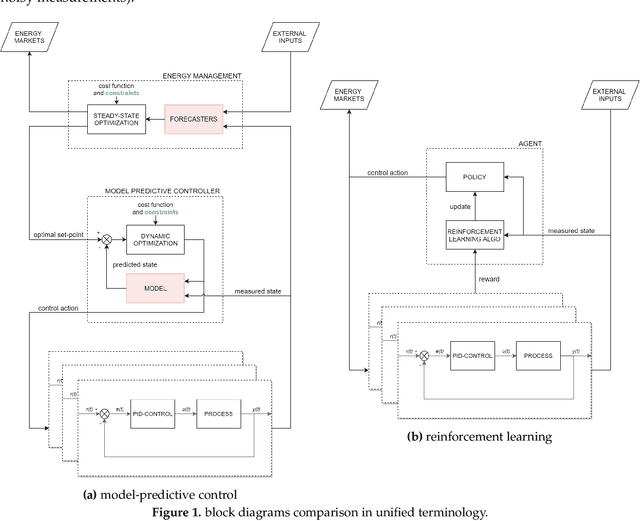

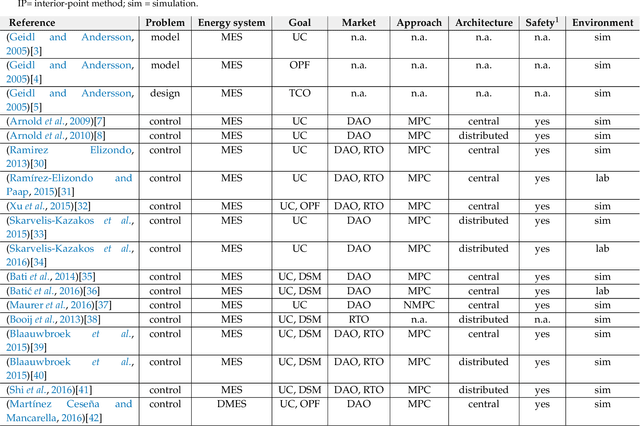

Abstract:Model-predictive-control (MPC) offers an optimal control technique to establish and ensure that the total operation cost of multi-energy systems remains at a minimum while fulfilling all system constraints. However, this method presumes an adequate model of the underlying system dynamics, which is prone to modelling errors and is not necessarily adaptive. This has an associated initial and ongoing project-specific engineering cost. In this paper, we present an on- and off-policy multi-objective reinforcement learning (RL) approach, that does not assume a model a priori, benchmarking this against a linear MPC (LMPC - to reflect current practice, though non-linear MPC performs better) - both derived from the general optimal control problem, highlighting their differences and similarities. In a simple multi-energy system (MES) configuration case study, we show that a twin delayed deep deterministic policy gradient (TD3) RL agent offers potential to match and outperform the perfect foresight LMPC benchmark (101.5%). This while the realistic LMPC, i.e. imperfect predictions, only achieves 98%. While in a more complex MES system configuration, the RL agent's performance is generally lower (94.6%), yet still better than the realistic LMPC (88.9%). In both case studies, the RL agents outperformed the realistic LMPC after a training period of 2 years using quarterly interactions with the environment. We conclude that reinforcement learning is a viable optimal control technique for multi-energy systems given adequate constraint handling and pre-training, to avoid unsafe interactions and long training periods, as is proposed in fundamental future work.
Direct Load Control of Thermostatically Controlled Loads Based on Sparse Observations Using Deep Reinforcement Learning
Jul 26, 2017
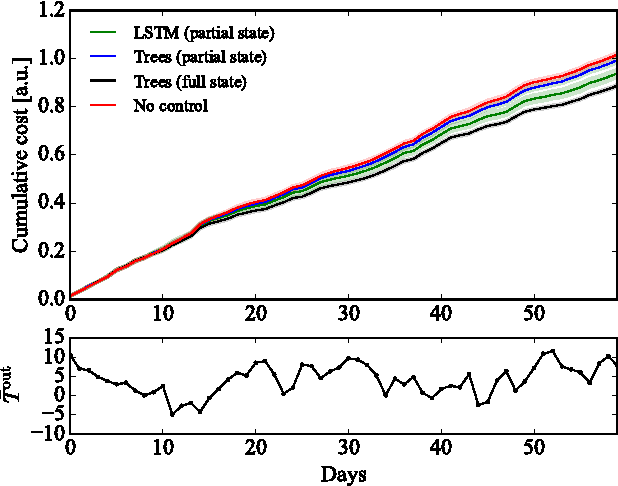
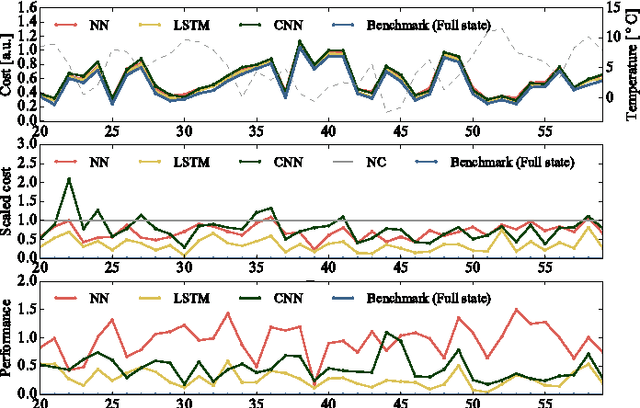
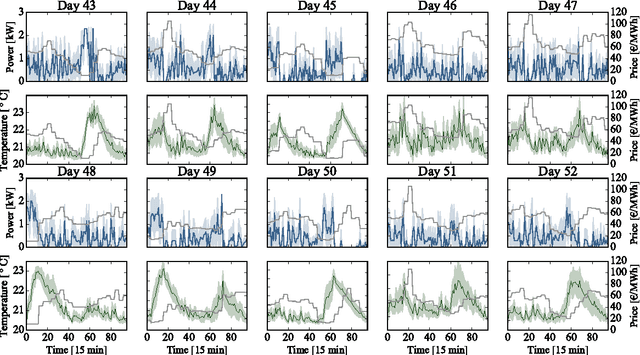
Abstract:This paper considers a demand response agent that must find a near-optimal sequence of decisions based on sparse observations of its environment. Extracting a relevant set of features from these observations is a challenging task and may require substantial domain knowledge. One way to tackle this problem is to store sequences of past observations and actions in the state vector, making it high dimensional, and apply techniques from deep learning. This paper investigates the capabilities of different deep learning techniques, such as convolutional neural networks and recurrent neural networks, to extract relevant features for finding near-optimal policies for a residential heating system and electric water heater that are hindered by sparse observations. Our simulation results indicate that in this specific scenario, feeding sequences of time-series to an LSTM network, which is a specific type of recurrent neural network, achieved a higher performance than stacking these time-series in the input of a convolutional neural network or deep neural network.
A practical approach to ontology-enabled control systems for astronomical instrumentation
Oct 21, 2013



Abstract:Even though modern service-oriented and data-oriented architectures promise to deliver loosely coupled control systems, they are inherently brittle as they commonly depend on a priori agreed interfaces and data models. At the same time, the Semantic Web and a whole set of accompanying standards and tools are emerging, advocating ontologies as the basis for knowledge exchange. In this paper we aim to identify a number of key ideas from the myriad of knowledge-based practices that can readily be implemented by control systems today. We demonstrate with a practical example (a three-channel imager for the Mercator Telescope) how ontologies developed in the Web Ontology Language (OWL) can serve as a meta-model for our instrument, covering as many engineering aspects of the project as needed. We show how a concrete system model can be built on top of this meta-model via a set of Domain Specific Languages (DSLs), supporting both formal verification and the generation of software and documentation artifacts. Finally we reason how the available semantics can be exposed at run-time by adding a "semantic layer" that can be browsed, queried, monitored etc. by any OPC UA-enabled client.
 Add to Chrome
Add to Chrome Add to Firefox
Add to Firefox Add to Edge
Add to Edge